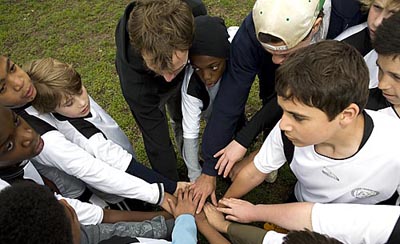Brooklyn
By Noah Davis ’05
Half a block behind me, Thomas Jefferson is lost in conversation with Anna Wintour, Vogue‘s editor-in-chief.
In front of me, three members of a dodgeball team, clad in American Apparel’s finest red and white booty shorts, pass a kickball among themselves. The fourth member of the team and I discuss the difficulties of managing our interns at work.

Noah Davis ’05, who says his Park Slope neighborhood meets the “need to connect,” pauses on Smith Street near his apartment. Photograph by Ryan Heffernan ’05.
The occasion is Trick or Drink, the Bates Halloween tradition, but instead of visiting a few Bates residences on a chilly Lewiston night, our costumed group — representing Bates classes of 2006, 2005, 2004, and 2002 — walks past tire shops and apartment buildings on Fourth Avenue in the Park Slope neighborhood of Brooklyn.
Mustering a quorum for a Brooklyn edition of Trick or Drink wasn’t hard. About 150 alums live in the adjoining Brooklyn neighborhoods of Park Slope, Carroll Gardens, Cobble Hill, and Red Hook, just across the East River. This set of neighborhoods is about 3.5 square miles in size, or equivalent to a chunk of Lewiston bounded by Great Falls and Exit 80 on the south, and the Auburn Mall and Thorncrag Bird Sanctuary to the north. Of those 150 alums, more than 100 are BOLD alums (Bobcats of the Last Decade), with more arriving each passing month.
But more than the numbers, a familiar sense of community in our Brooklyn neighborhoods made it possible to start up a local version of a Bates tradition. And for us Batesies, this community vibe is defined in part by the huge scale of what’s around us.
Despite its 8.2 million residents, New York City can be an isolating place. On the subway ride to my office in Soho, I’m surrounded by commuters, yet we’re just individuals thrown into the worst carpool ever, with nothing to do except listen to our iPods, read Esquire, and avoid eye contact. It’s the antithesis of how we navigated the Bates quad.
But after work, when I get off the F train at Carroll Street and climb one flight of stairs onto Smith Street, though I’m four blocks from my apartment I know I’m home. The street is filled with mom-and-pop shops, small restaurants, and three-story buildings. There’s the bodega where the owners know my name. The bartenders at Brooklyn Social where I occasionally play pool don’t, but I don’t need Cheers. What I need, and what I get, is better: an almost imperceptible nod of recognition when I enter. That’s enough.

Noah Davis ’05 and a friend began coaching a youth soccer team in the spring. “From my perspective, the team provides a new way to interact with the community,” says Davis. Photograph by Ryan Heffernan ’05.
Looking back, I was drawn to this section of Brooklyn for many of the same reasons I chose Bates. More than 100,000 people live in these neighborhoods, but there’s an undeniable sense of community. Like Bates and Lewiston, it feels real, not quaint. “Very neighborhoody,” says John Scott Johnson ’04, a former Park Slope resident.
Current and longtime Park Slope resident Doug Olney ’81 has exited the young-alum ranks but easily makes the Bates-Brooklyn connection. When he looks around he sees, quite literally, Bates. “My neighborhood was developed around the same time as Bates, the late 1800s and early 1900s, so the style is similar to buildings like Coram and Hedge,” he says. “Despite renovation and renewal in the area, the essential features remain recognizable, like when you return to Bates for Reunion.”
Craig Teicher ’01, a published poet and editor at Publishers Weekly, decamped to Brooklyn four years ago after living in a “very expensive closet” in Manhattan for two years during graduate school at Columbia. He moved into a two-bedroom apartment on Court Street that costs about as much as his “closet,” and now lives there with his wife and 10-month old child. “I love the on-the-fly social aspect of the neighborhood,” says Teicher, who keeps remembering Bates friends that live close by during our phone conversation.
Though cheap rents initially drew many of us here, we’ve found a place that meets more than a financial need — a need to connect. “Bates taught us how to create a sense of community and then take that wherever we go,” says Sara Kravitz ’04, who lives in Cobble Hill, a historically Italian neighborhood known for its family-run shops.
This spring, a friend from high school and I started coaching an under-12 soccer team. Another friend, Chet Clem ’05, the stalwart goalie of my Bates intramural soccer teams, occasionally helps. At first, our players’ parents couldn’t understand why we were volunteering: “You guys don’t, um, have kids, right?” But our enthusiasm won them over. From my perspective, the team provides a new way to interact with the community. Doug Olney, a Park Slope resident since 1983, knows how it works — Brooklyn’s many, many communities” creates alluring possibilities for civic involveme’nt. “It really pulls you in and stays with you.”
There are, of course, grumblings about the area’s gentrification. The average Park Slope rent has almost tripled since 2005, and American Apparel and Urban Outfitters are slowly replacing tiny boutiques. Soon the Bates crew might be priced out, but the BBQs will continue at apartments in another part of Brooklyn. Bobcats know how to find each other.
A rhetoric major, Noah Davis ’05 is an associate editor at mediabistro.com in New York and a staff writer at Goal.com. As a freelancer, he published features in The Onion‘s AV Club, Penthouse, and Time Out New York.